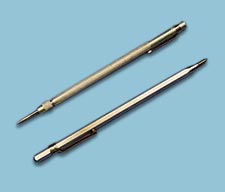- 01: Introduction
- 02: History
- 03: Propellants, Firearms, and Ammunition Development
- 04: Modern Firearms Manufacture
- 05: Small Arms Ammunition
- 06: Evidence Handling Procedures
- Introduction
- Objectives
- AFTE Knowledge and Ability Factors
- Types of Evidence
- Associative Evidence
- The Crime Scene
- Evidence Submission
- Laboratory Evidence Handling
- Case Tracking Within the Laboratory
- Firearm and Toolmark Examination Considerations
- Selected Bibliography
- 07: Equipment and Instrumentation
- 08: Examination of Firearms
- 09: Cartridge and Shotshell Examination
- 10: Characterization and Evaluation of Fired Projectiles
- 11: Bullet Comparison and Identification
- 12: Gunshot Residue and Distance Determination
- 13: Toolmark Identification
- 14: Communicating Results
- Resources


Fired Bullets
Home > Evidence Handling Procedures > The Crime Scene > Collection of Evidence > Fired Bullets
Fired bullets are frequently found at crime scenes and after shooting incidents; they may be found on the floor, in walls, floors, ceilings, mattresses, and inside electrical appliances.
If the number of fired cartridge cases exceeds the number of bullets found in the victim(s), this indicates that a further search for remaining bullets may be necessary. If the number of bullets appears to exceed the number of cartridge cases, this may indicate that some of the bullets may be fragmented.
Bullets are frequently received from medical examiners during or after autopsies. Medical examiners should be knowledgeable in the proper packaging of evidence and chain-of-custody requirements.

Metal scribes
Each jurisdiction has specific protocols for marking fired bullets and fragments. Some jurisdictions require that only the packaging should be marked; others require that the items are also marked. If agency protocols mandate the direct marking of evidence, a metal scribe should be used to mark the base of the projectile. Marking the nose area may disturb or cause the loss of trace evidence. The bearing surface of an evidence bullet should never be marked as this is the area critical to the identification process. It may not be possible to properly mark mutilated bullets.
To limit damage and to preserve the unique microscopic marks that they bear, fired bullets should be placed in separate pasteboard boxes or plastic containers along with any apparently related fragments. Within the container, the bullet should be wrapped in a small amount of unused wrapping paper to preserve any trace evidence that may be present.
Other materials, such as envelopes, may be used to package fired bullet evidence.




